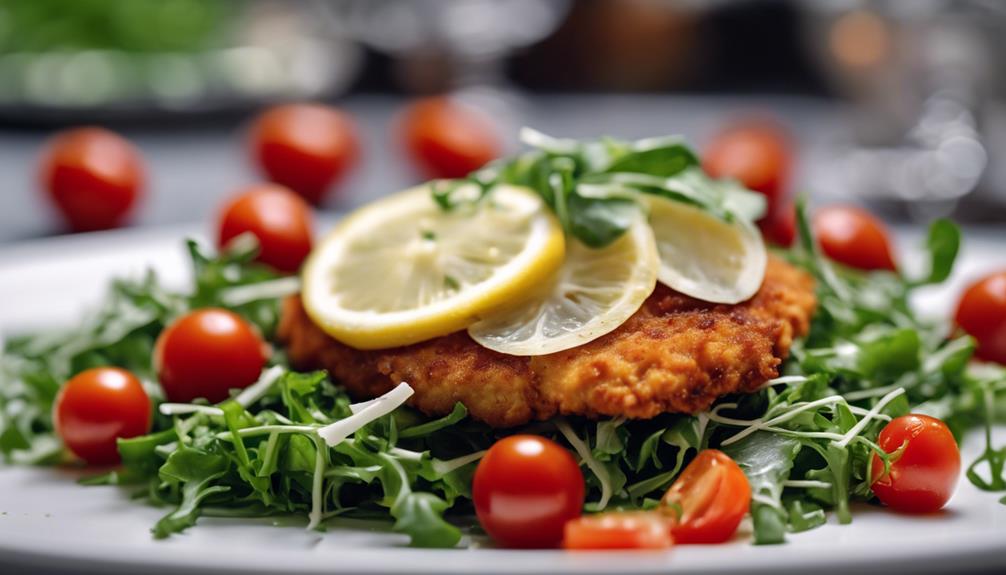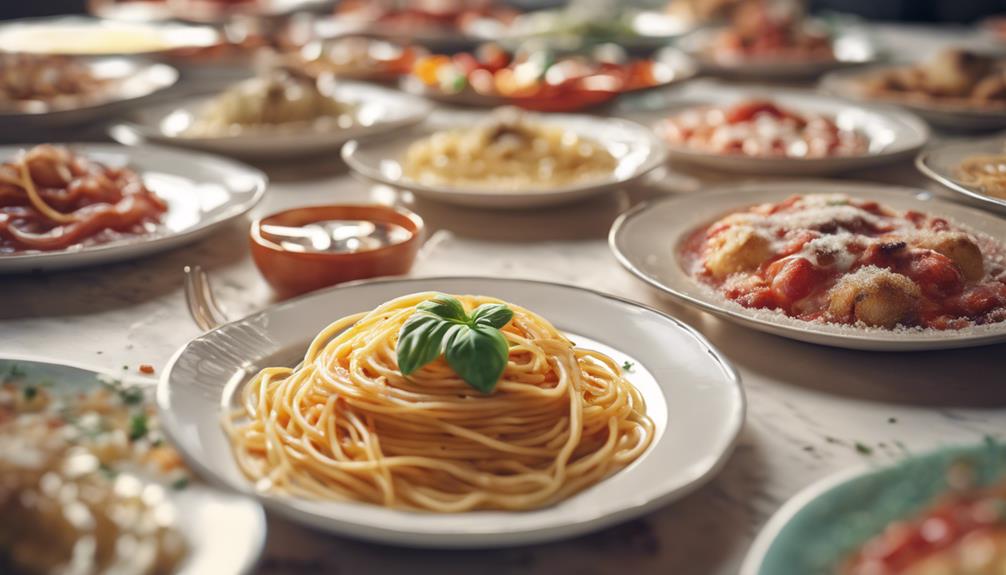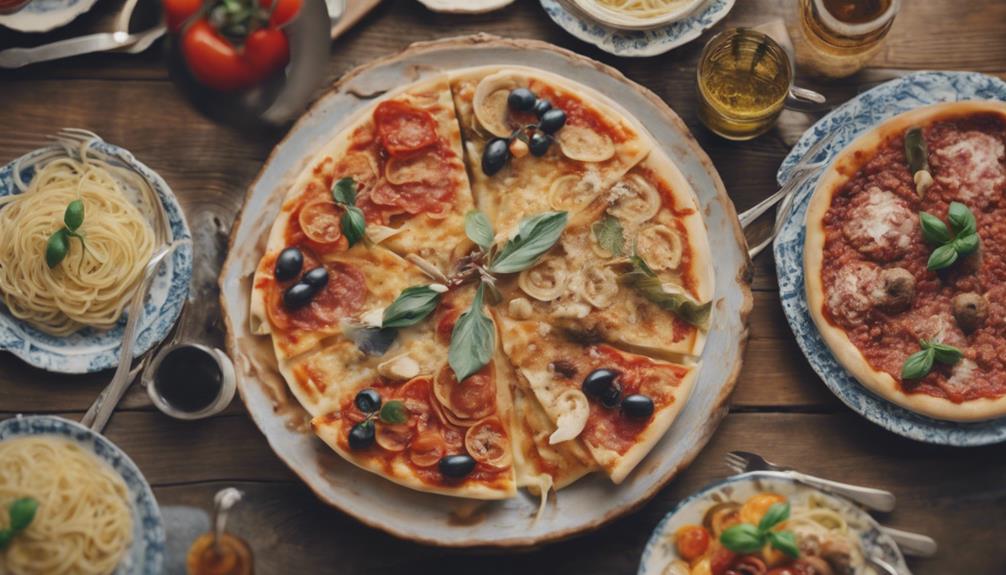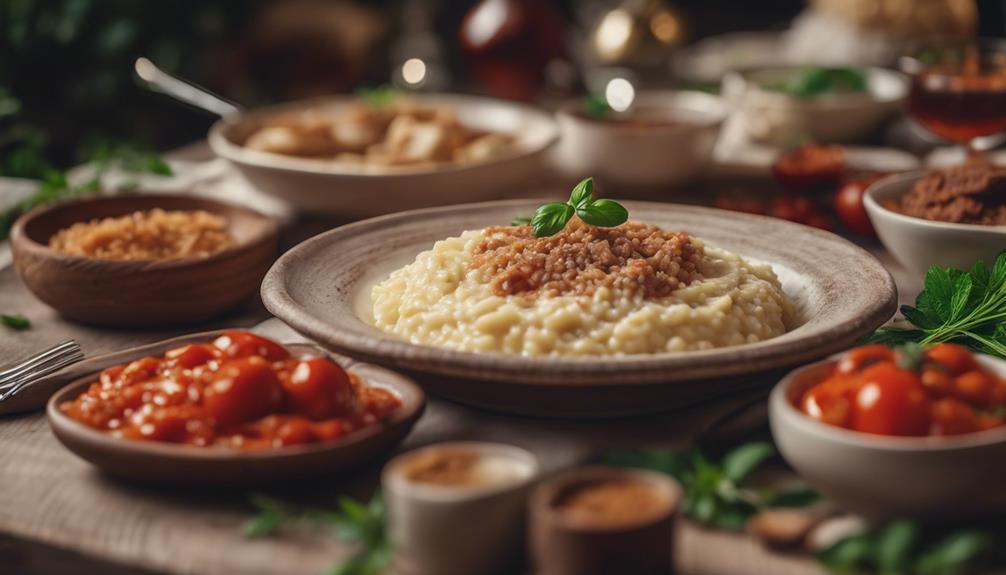Indulge in the delectable Chicken Milanese, revered for its crispy exterior embracing tender, juicy chicken. Start by flattening the breasts and coating them meticulously in flour, eggs, and breadcrumbs. Fry until golden brown, ensuring a perfect crunch. Serve with sides like pasta or a zesty arugula salad. Store leftovers for future enjoyment and reheat for a quick meal. This classic dish offers around 522 calories per serving, rich in protein, fats, and carbohydrates. Explore variations like using veal or pork, adding cheese, or experimenting with seasonings. Elevate your culinary experience with this Italian favorite's delightful textures and flavors.
Key Takeaways
- Flatten chicken breasts for even cooking and crispy texture.
- Coat chicken in flour, egg wash, and breadcrumbs for a crunchy exterior.
- Fry in hot oil until golden brown for a classic Italian crispiness.
- Serve with lemon wedge for a zesty touch.
- Customize with herbs or cheeses to add personal flair.
Ingredients
For the essential Chicken Milanese, gather boneless, skinless chicken breasts, eggs, all-purpose flour, breadcrumbs, and vegetable oil for frying. The breading process is vital in achieving that crispy texture and flavor. Start by coating the chicken in flour to create a base for the breadcrumbs to adhere to.
Next, dip the chicken in an egg mixture to help the breadcrumbs stick and form a delicious crust when cooked. The breadcrumbs play a key role in providing that satisfying crunch that Chicken Milanese is known for.
Traditional Chicken Milanese is often served with lemon wedges on the side. The hint of citrus adds an invigorating touch to the dish, balancing out the richness of the fried chicken. Additionally, the lemon can be squeezed over the chicken just before serving to enhance the overall taste. This simple addition elevates the flavors and brings a zesty brightness to each bite.
Preparation Steps
To prepare Chicken Milanese, you'll start by flattening the chicken breasts to guarantee even cooking and a crispy texture.
Next, you'll coat the chicken in flour, eggs, and breadcrumbs in that order to achieve the traditional Milanese-style breading.
Then, fry the coated chicken in suitable oils until it reaches a golden brown, crispy perfection.
Coating the Chicken
Prepare your breading station with flour, egg wash, and breadcrumbs to coat the chicken for Chicken Milanese. Each component plays an essential role in creating the perfect breaded chicken cutlets. The flour serves as the initial coating, allowing the egg wash to adhere to the chicken properly. This step is important as it creates a sticky surface for the breadcrumbs to stick to, ensuring a crispy texture after frying. The egg wash, a mixture of beaten eggs and sometimes milk or water, adds moisture to the chicken while acting as a binder for the breadcrumbs. This helps the breadcrumbs adhere to the chicken, forming that signature crispy outer layer. The breadcrumbs, often seasoned with herbs and cheese, provide the final coating that gives the breaded chicken its golden-brown finish. Properly coating the chicken in each element guarantees a flavorful and satisfying Chicken Milanese experience.
| Component | Function |
|---|---|
| Flour | Initial coating for egg wash adhesion |
| Egg Wash | Adds moisture and acts as a binder |
| Breadcrumbs | Provides the crispy outer coating |
Frying to Perfection
Achieve perfect crispiness by frying the breaded chicken cutlets until they reach a golden brown hue. Start by heating oil in a large skillet over medium-high heat. Once the oil is hot, carefully add the breaded cutlets, ensuring not to overcrowd the pan.
Fry the chicken for about 3-4 minutes per side, or until they're beautifully golden brown and crunchy. It's important to monitor the oil temperature to maintain consistent frying, ensuring that the chicken cooks evenly and achieves the desired crispiness.
When frying the breaded cutlets, remember to maintain the oil temperature around 350°F to 375°F, as this will help the chicken cook quickly while maintaining its crispy coating.
Once the cutlets are fried to perfection, transfer them to a wire rack set over a baking sheet. This step allows any excess oil to drain off, preventing the cutlets from becoming soggy and helping them retain their delightful crispiness.
Frying the breaded chicken cutlets is an essential step in preparing a delicious Chicken Milanese, ensuring that each bite is a delightful combination of crispy exterior and juicy interior.
Serving With Sides
Enhance your Chicken Milanese dining experience by thoughtfully selecting and preparing complementary side dishes that elevate the flavors and textures of the crispy chicken cutlets.
When serving this classic Italian chicken dish, it's essential to think about side dishes that will complement the crunchy exterior and juicy interior of the Chicken Milanese. Traditional options like pasta, salad, or roasted vegetables work well to balance the dish's richness.
For an invigorating contrast, a lemony arugula salad can provide a zesty and light accompaniment. If you prefer something heartier, creamy mashed potatoes or buttery spaghetti aglio e olio could be the perfect choice.
To add a healthy twist, ponder incorporating seasonal vegetables, grains, or legumes that not only enhance the flavors but also offer nutritional benefits.
Cooking Technique
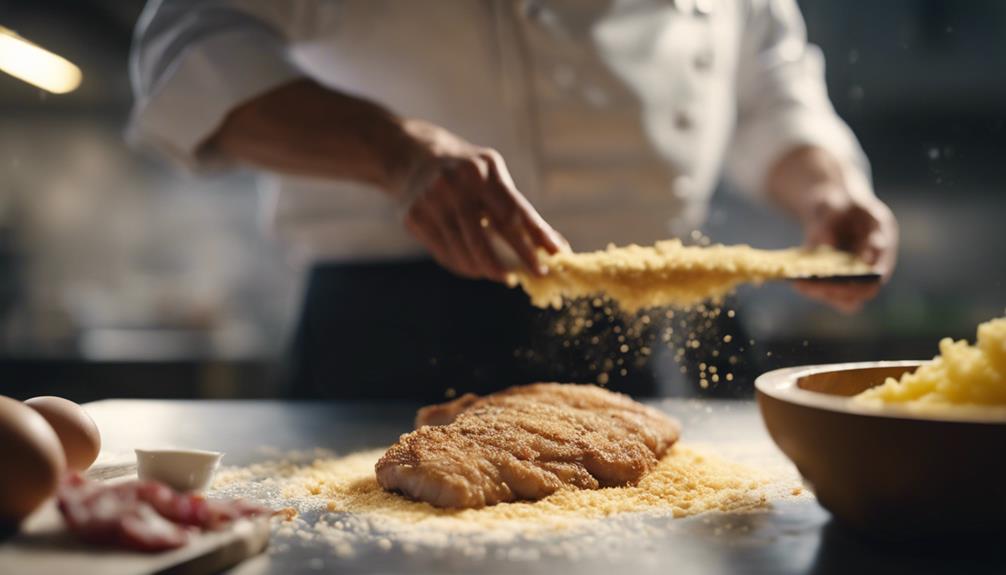
For best results, make sure that you're pounding the chicken breasts to an even thickness before starting the breading process for Chicken Milanese.
- Breading Station Setup:
Begin by setting up a breading station with flour, salt, and pepper for the initial coating. Follow this with an egg wash and then a breadcrumb mixture for that desired crispy exterior.
- Frying in Hot Oil:
Properly frying the coated chicken in hot oil until it reaches a golden brown color is essential in achieving the signature crispy texture of Chicken Milanese. Make sure the oil is hot enough to create that perfect crunch.
- Crispy Texture:
To maintain the crispy texture, drain the fried cutlets on a wire rack after cooking to prevent sogginess. This step is important in preserving the delightful crunch of the dish.
Serving Suggestions
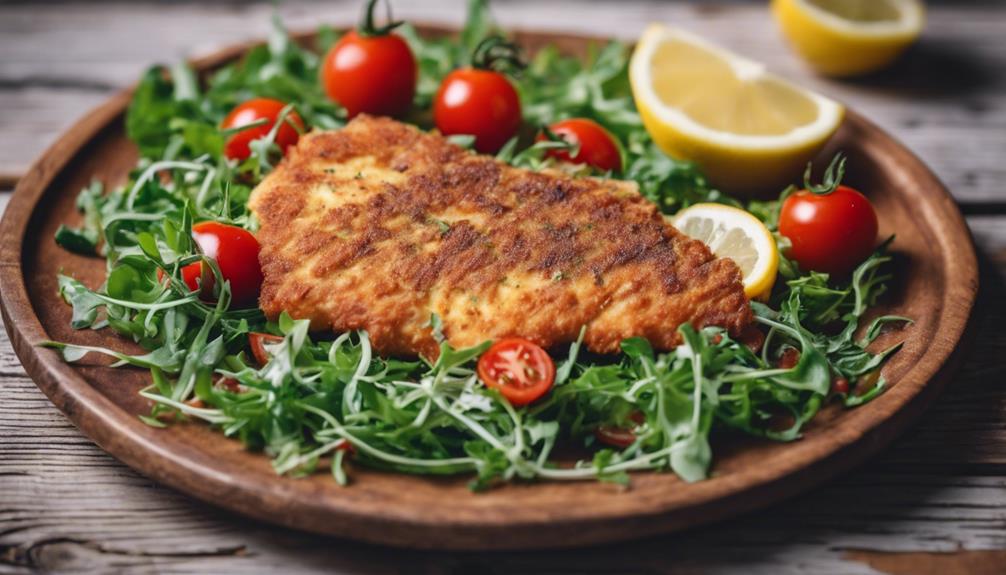
To complement the crispy texture and savory flavors of Chicken Milanese, consider various serving suggestions that elevate this classic dish. Start by serving the Crispy Chicken Milanese with a lemon wedge, allowing a splash of citrus to enhance each bite.
For a lighter option, pair it with a side salad dressed in balsamic vinaigrette, adding a revitalizing contrast to the fried chicken. If you prefer a heartier meal, consider accompanying the Chicken Milanese with roasted vegetables such as asparagus, broccoli, or cherry tomatoes for a delicious combination of flavors.
To further enhance the dish, serve it with creamy mashed potatoes for a comforting touch or a cucumber and tomato salad for a rejuvenating twist. For a complete Italian dining experience, include a side of garlic bread or a classic Caprese salad with fresh mozzarella, tomatoes, and basil.
These serving suggestions won't only elevate the taste of the Chicken Milanese but also provide a well-rounded meal that celebrates this Italian classic.
Make-Ahead Tips
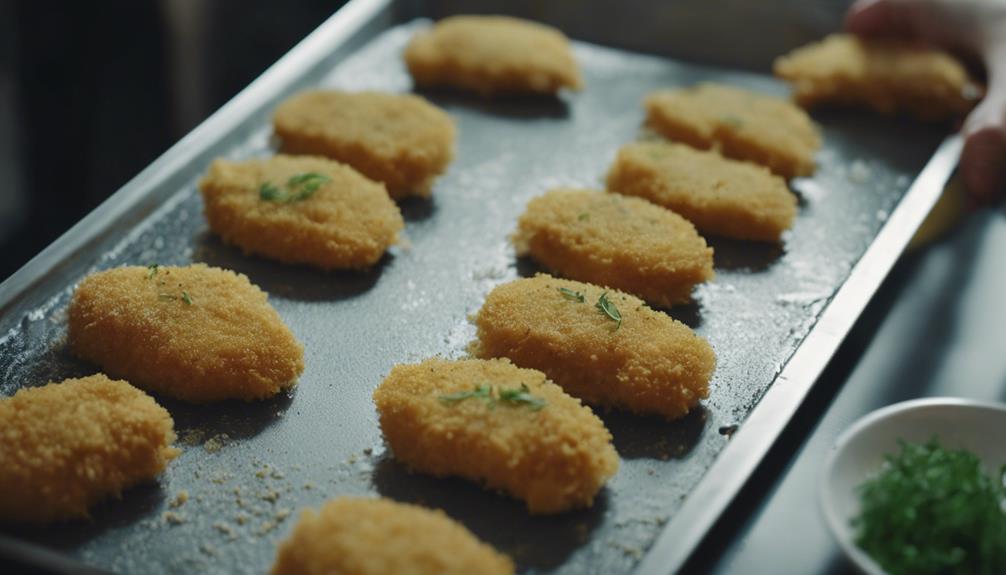
Consider preparing Chicken Milanese ahead of time by following these make-ahead tips to save time and guarantee a convenient dining experience.
- Storage Tips:
- Store Chicken Milanese in an airtight container in the refrigerator for up to 3 days or freeze for up to 2 months for longer preservation.
- Keep the salad separate from the chicken when storing to prevent it from becoming soggy and maintain its freshness.
- Reheating Instructions:
- For best results, reheat the Chicken Milanese in the oven at 350°F for 8-10 minutes. This method helps maintain the crispy texture and ensures the flavors are rejuvenated.
- Additional Recommendation:
- To explore more culinary insights and receive exclusive content, subscribe to Chef Billy's newsletter. This way, you can stay updated on the latest make-ahead tips and enhance your cooking skills for a delightful dining experience.
Nutritional Info
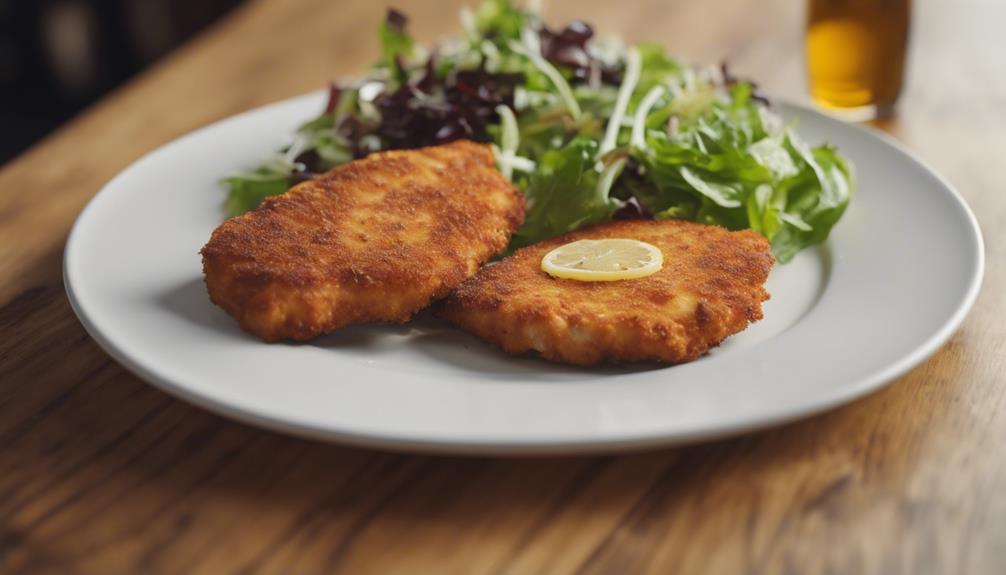
When considering the nutritional information of Chicken Milanese, it's important to note the calorie count and macronutrient breakdown.
This dish typically contains around 522 calories per serving, providing 47g of protein and 24g of fat.
Understanding these points can help you make informed decisions about your dietary intake and overall meal planning.
Calorie Count
When considering the nutritional content of this classic dish, it's crucial to keep a few key points in mind:
- Balanced Macronutrients: A serving of Chicken Milanese contains 27g of carbohydrates, 47g of protein, and 24g of fat, offering a good balance of essential nutrients to fuel your body.
- Vitamins and Minerals: In addition to its macronutrient profile, Chicken Milanese is a source of vitamins A and C, calcium, and iron, contributing to your daily intake of important nutrients.
- Dietary Considerations: A serving of Chicken Milanese also contains 178mg of cholesterol and 577mg of sodium. If you're monitoring your intake of these components for dietary considerations, it's advisable to be mindful of portion sizes and accompanying side dishes.
Enjoying Chicken Milanese in moderation can be a delicious and nutritious addition to your meal rotation.
Macronutrient Breakdown
The macronutrient breakdown of Chicken Milanese includes 27g of carbohydrates, 47g of protein, and 24g of fat per serving. With a total of approximately 522 calories, this dish offers a balanced combination of these macronutrients.
Protein plays a significant role in muscle repair and growth, while carbohydrates provide energy for daily activities. The fat content contributes to satiety and aids in the absorption of fat-soluble vitamins. Chicken Milanese, with its 47g of protein, is particularly beneficial for maintaining muscle mass and overall body function.
It's important to note that this dish also contains 178mg of cholesterol and 577mg of sodium per serving. While moderate cholesterol intake is acceptable for most individuals, those with specific dietary restrictions may need to monitor their consumption. Additionally, the sodium content should be considered for individuals managing their salt intake.
Chef's Tips
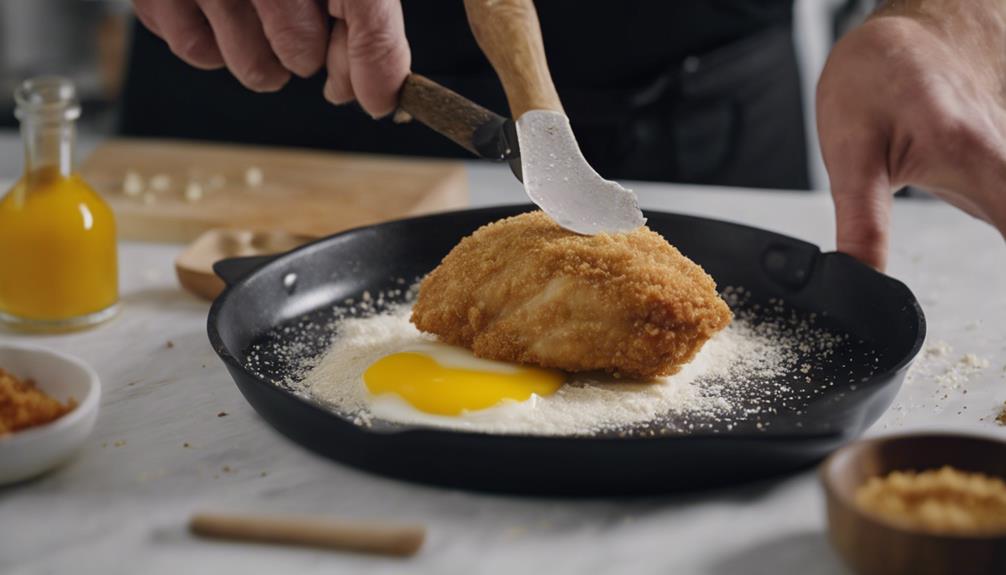
To achieve the perfect Chicken Milanese, make sure you pound the chicken breasts to an even thickness for consistent cooking and a crispy texture. Chef's tips for mastering this Italian classic also include draining the coated cutlets on a wire rack before frying to prevent sogginess and ensuring a larger surface area on the cutlets before breading and frying for extra crispiness.
Ideal frying techniques play a vital role in achieving the desired golden-brown results. Following culinary producer Nicole McLaughlin's advice can help you elevate your Chicken Milanese game at home. It's crucial to pay attention to the finer details such as breading station organization to guarantee a seamless cooking process and a delicious end result.
Recipe Variations
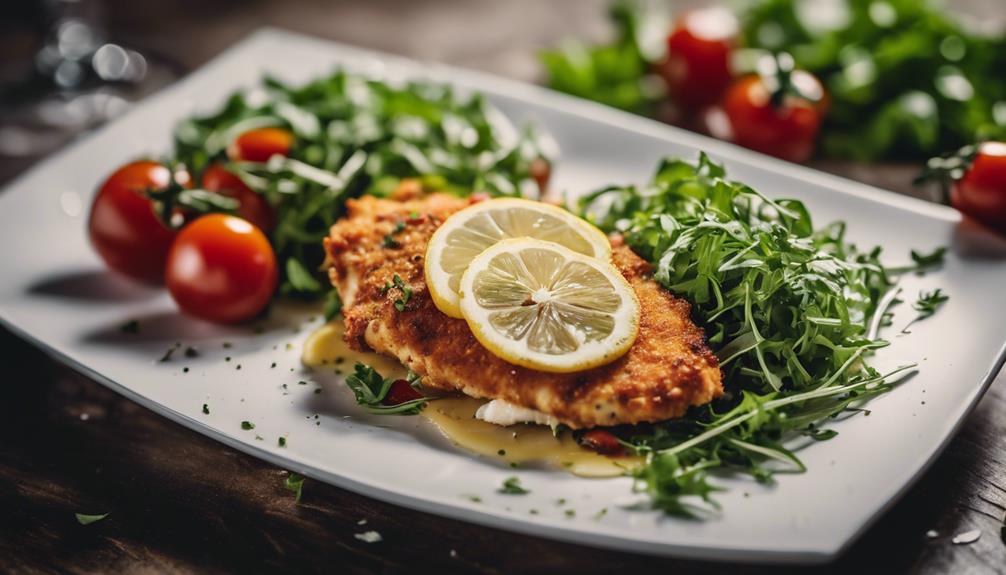
Consider incorporating different meats, cheeses, and garnishes to create unique twists on the classic Chicken Milanese recipe. You can experiment with using veal or pork instead of chicken for a delightful variation.
Enhance the breading mixture by adding Parmesan cheese or mozzarella to give your Chicken Milanese a cheesy kick. For an invigorating touch, try garnishing your dish with lemon wedges to add a citrusy zing.
Another option is to drizzle a balsamic reduction over the breaded chicken for a tangy flavor profile. To lighten up the dish, opt for baking or air-frying the breaded chicken instead of traditional pan-frying.
Additionally, you can customize the taste of your Chicken Milanese by playing around with different seasonings and herbs in the breading mixture. These variations will add depth and personal flair to this crispy Italian classic, making it a versatile dish that can suit various preferences.
Frequently Asked Questions
What Is Chicken Milanese Made Of?
To make Chicken Milanese, you'll need thinly sliced chicken breast halves. Coat them in flour, egg, and breadcrumbs. The breading includes all-purpose flour, eggs, salt, pepper, and breadcrumbs. Fry in vegetable oil until golden brown and crispy.
What's the Difference Between Chicken Milanese and Chicken Cutlets?
When comparing Chicken Milanese to regular cutlets, the key difference lies in the breading method. Milanese-style chicken gets coated in breadcrumbs for that signature crispiness. It's like comparing apples and oranges – similar yet distinct.
What Is the Difference Between Chicken Parm and Chicken Milanese?
To differentiate Chicken Parm and Chicken Milanese, note that Chicken Parm is topped with marinara sauce and cheese, while Chicken Milanese is served with lemon. The former is saucier and cheesier, originating from Italian-American roots, compared to the Milanese classic.
What Is the Origin of Chicken Milanese?
To understand the origin of Chicken Milanese, look to Milan, Italy, where the crispy classic emerged. Coating chicken in flour, eggs, and breadcrumbs, then frying to perfection, this dish brings a taste of Milan's culinary heritage to your plate.
Would Chicken Milanese Taste Good with Capers?
Chicken Milanese is a tasty dish that would pair perfectly with capers. The tangy and briny flavor of capers adds a deliciously zesty element to the crispy, breaded chicken. It’s a classic combination that enhances the flavors of Italian dishes with capers usage. Buon appetito!
Conclusion
To sum up, Chicken Milanese is a classic Italian dish that offers a crispy and flavorful experience.
Have you ever imagined biting into a perfectly breaded chicken cutlet, paired with a fresh salad and a squeeze of lemon?
It's a dish that brings together simplicity and sophistication in every bite.
Try making this dish at home and impress your family and friends with your culinary skills!
